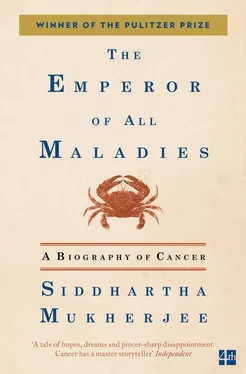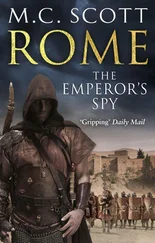Galen died in Rome in 199 AD, but his influence on medicine stretched over the centuries. The black-bile theory of cancer was so metaphorically seductive that it clung on tenaciously in the minds of doctors. The surgical removal of tumors—a local solution to a systemic problem—was thus perceived as a fool’s operation. Generations of surgeons layered their own observations on Galen’s, solidifying the theory even further. “Do not be led away and offer 125to operate,” John of Arderne wrote in the mid-1300s. “It will only be a disgrace to you.” Leonard Bertipaglia, perhaps the most influential surgeon of the fifteenth century, added his own admonishment: “Those who pretend 126to cure cancer by incising, lifting, and extirpating it only transform a nonulcerous cancer into an ulcerous one. . . . In all my practice, I have never seen a cancer cured by incision, nor known anyone who has.”
Unwittingly, Galen may actually have done the future victims of cancer a favor—at least a temporary one. In the absence of anesthesia and antibiotics, most surgical operations performed in the dank chamber of a medieval clinic—or more typically in the back room of a barbershop with a rusty knife and leather straps for restraints—were disastrous, life-threatening affairs. The sixteenth-century surgeon Ambroise Paré described charring tumors 127with a soldering iron heated on coals, or chemically searing them with a paste of sulfuric acid. Even a small nick in the skin, treated thus, could quickly suppurate into a lethal infection. The tumors would often profusely bleed at the slightest provocation.
Lorenz Heister, an eighteenth-century German physician, once described a mastectomy in his clinic as if it were a sacrificial ritual: “Many females can stand the operation 128with the greatest courage and without hardly moaning at all. Others, however, make such a clamor that they may dishearten even the most undaunted surgeon and hinder the operation. To perform the operation, the surgeon should be steadfast and not allow himself to become discomforted by the cries of the patient.”
Unsurprisingly, rather than take their chances with such “undaunted” surgeons, most patients chose to hang their fates with Galen and try systemic medicines to purge the black bile. The apothecary 129thus soon filled up with an enormous list of remedies for cancer: tincture of lead, extracts of arsenic, boar’s tooth, fox lungs, rasped ivory, hulled castor, ground white-coral, ipecac, senna, and a smattering of purgatives and laxatives. There was alcohol and the tincture of opium for intractable pain. In the seventeenth century, a paste of crab’s eyes, at five shillings a pound, was popular—using fire to treat fire. The ointments and salves grew increasingly bizarre by the century: goat’s dung, frogs, crow’s feet, dog fennel, tortoise liver, the laying of hands, blessed waters, or the compression of the tumor with lead plates.
Despite Galen’s advice, an occasional small tumor was still surgically excised. (Even Galen had reportedly performed such surgeries, possibly for cosmetic or palliative reasons.) But the idea of surgical removal of cancer as a curative treatment was entertained only in the most extreme circumstances. When medicines and operations failed, doctors resorted to the only established treatment for cancer, borrowed from Galen’s teachings: an intricate series of bleeding and purging rituals to squeeze the humors out of the body, as if it were an overfilled, heavy sponge.
Vanishing Humors
Rack’t carcasses 130make ill Anatomies.
—John Donne
In the winter of 1533, a nineteen-year-old student from Brussels, Andreas Vesalius, arrived at the University of Paris hoping to learn Galenic anatomy and pathology and to start a practice in surgery. To Vesalius’s shock and disappointment, the anatomy lessons at the university were in a preposterous state of disarray. The school lacked a specific space for performing dissections. The basement of the Hospital Dieu, where anatomy demonstrations were held, was a theatrically macabre space where instructors hacked their way through decaying cadavers while dogs gnawed on bones and drippings below. “Aside from the eight muscles 131of the abdomen, badly mangled and in the wrong order, no one had ever shown a muscle to me, nor any bone, much less the succession of nerves, veins, and arteries,” Vesalius wrote in a letter. Without a map of human organs to guide them, surgeons were left to hack their way through the body like sailors sent to sea without a map—the blind leading the ill.
Frustrated with these ad hoc dissections, Vesalius decided to create his own anatomical map. He needed his own specimens 132, and he began to scour the graveyards around Paris for bones and bodies. At Montfaucon, he stumbled upon the massive gibbet of the city of Paris, where the bodies of petty prisoners were often left dangling. A few miles away, at the Cemetery of the Innocents, the skeletons of victims of the Great Plague lay half-exposed in their graves, eroded down to the bone.
The gibbet and the graveyard—the convenience stores for the medieval anatomist—yielded specimen after specimen for Vesalius, and he compulsively raided them, often returning twice a day to cut pieces dangling from the chains and smuggle them off to his dissection chamber. Anatomy came alive for him in this grisly world of the dead. In 1538, collaborating with artists in Titian’s studio, Vesalius began to publish his detailed drawings in plates and books—elaborate and delicate etchings charting the courses of arteries and veins, mapping nerves and lymph nodes. In some plates, he pulled away layers of tissue, exposing the delicate surgical planes underneath. In another drawing, he sliced through the brain in deft horizontal sections—a human CT scanner, centuries before its time—to demonstrate the relationship between the cisterns and the ventricles.
Vesalius’s anatomical project had started as a purely intellectual exercise but was soon propelled toward a pragmatic need. Galen’s humoral theory of disease—that all diseases were pathological accumulations of the four cardinal fluids—required that patients be bled and purged to squeeze the culprit humors out of the body. But for the bleedings to be successful, they had to be performed at specific sites in the body. If the patient was to be bled prophylactically (that is, to prevent disease), then the purging was to be performed far away from the possible disease site, so that the humors could be diverted from it. But if the patient was being bled therapeutically—to cure an established disease—then the bleeding had to be done from nearby vessels leading into the site.
To clarify this already foggy theory, Galen had borrowed an equally foggy Hippocratic expression, kat' 'i'xiu—Greek for “straight into”—to describe isolating the vessels that led “straight into” tumors. But Galen’s terminology had pitched physicians into further confusion. What on earth, they wondered, had Galen meant by “straight into”? Which vessels led “straight into” a tumor or an organ, and which led the way out? The instructions became a maze of misunderstanding. In the absence of a systematic anatomical map—without the establishment of normality—abnormal anatomy was impossible to fathom.
Vesalius decided to solve the problem by systematically sketching out every blood vessel and nerve in the body, producing an anatomical atlas for surgeons. “In the course of explaining the opinion 133of the divine Hippocrates and Galen,” he wrote in a letter, “I happened to delineate the veins on a chart, thinking that thus I might be able easily to demonstrate what Hippocrates understood by the expression kat' 'i'xiu, for you know how much dissension and controversy on venesection was stirred up, even among the learned.”
Читать дальше












